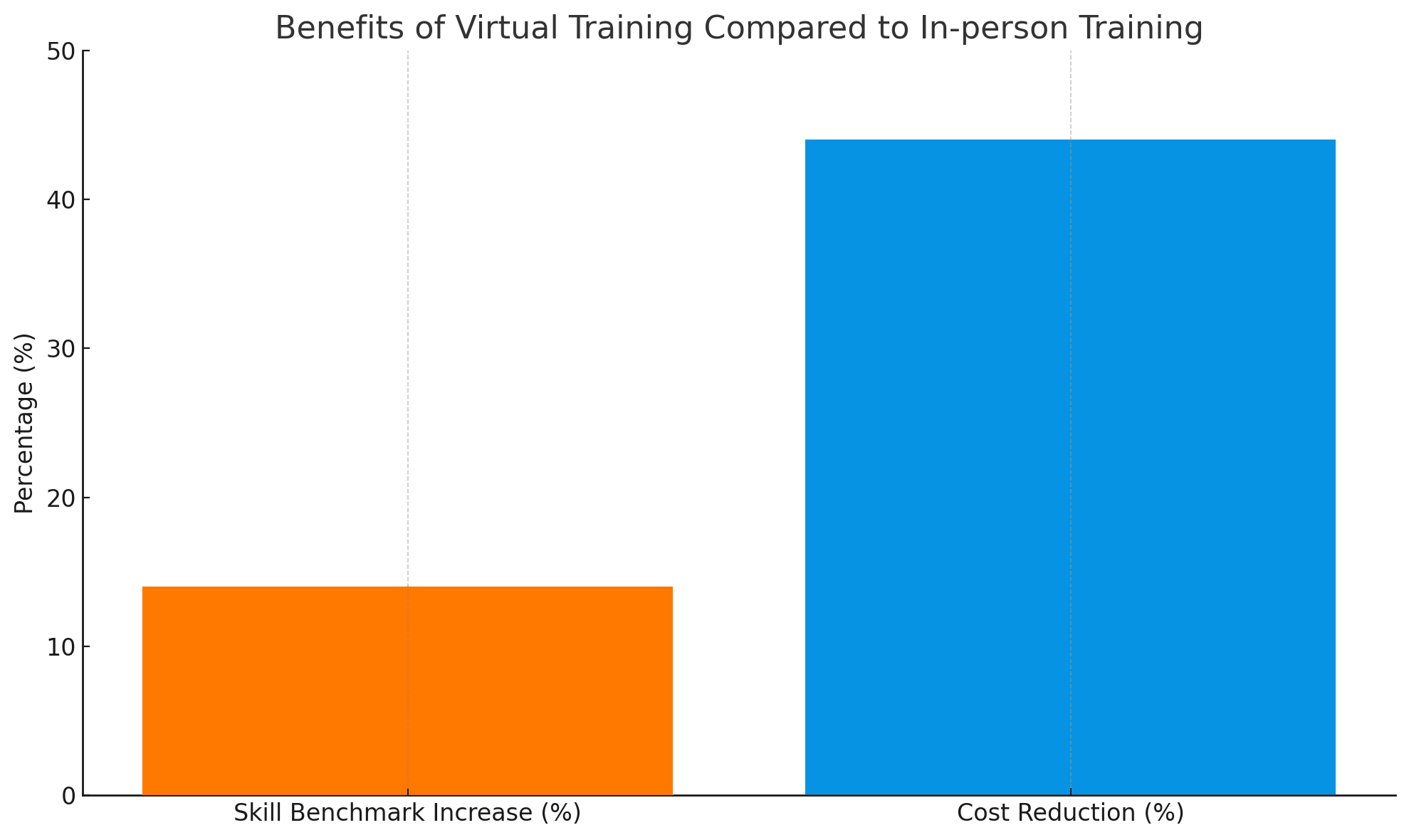In today's fast-paced digital landscape, businesses constantly seek innovative ways to stay ahead of the curve. One such avenue that has proven to be a game-changer is virtual training. By partnering with a reputable virtual training company, businesses can unlock a plethora of advantages.
Virtual training solutions not only offer flexibility in terms of time and location but also provide a cost-effective alternative to traditional on-site training methods. Moreover, these platforms are designed to be interactive, ensuring participants remain engaged and retain the information presented.
As businesses continue to globalize, the need for consistent and scalable training solutions becomes paramount. Virtual training platforms cater to this need, allowing companies to easily train employees across different regions. In essence, leveraging the expertise of a virtual training company can significantly enhance a business's operational efficiency and competitive edge.
Advancements in VR Training Techniques
The evolution of VR in training techniques has been nothing short of revolutionary. Here's a closer look at the advancements:
Experiential learning. With the progression in computer and graphical processing, VR has transformed training into a more immersive and meaningful experience. Training simulations in VR notably reduce the time to competency, ensuring trainees acquire skills more efficiently.
Preservation of knowledge. As many subject-matter experts approach retirement, industries like oil and gas, refining, and power generation are turning to VR to preserve and institutionalize their workforce knowledge.
Realistic environments. VR training simulations allow trainees to familiarize themselves with plant operations before setting foot in the actual plant. These environments utilize hardware devices like joysticks, data gloves, and head-mounted displays to enhance immersion.
Safety and cost efficiency. VR provides a safe environment for training, especially in industries where real-world training can be hazardous. This leads to fewer accidents, reduced injury-related costs, and, subsequently, lower insurance premiums.
Market growth. Virtual reality in the enterprise training market is poised for substantial growth, with projections indicating significant developments beyond 2030. Market demand, technological advancements, and the consistent need for training solutions propel this growth.
These advancements underscore the transformative potential of VR in reshaping training simulations and the broader landscape of workforce development.
Overview of Virtual Training Systems
Virtual training systems have become a cornerstone of modern learning, especially in the wake of the pandemic. These platforms, including Learning Management Systems (LMS) and Virtual Learning Environments (VLE), have made it increasingly feasible for educators and trainers to manage online courses. The shift from traditional face-to-face learning to digital channels has proven cost-effective and offers unparalleled flexibility. For instance, in remote scenarios, online learning platforms shine, transforming complex industrial content into vivid, realistic experiences.
Virtual training systems have become indispensable in the modern learning landscape, offering a blend of flexibility, interactivity, and real-world simulation. A prime example is a Hand Rehabilitation VR Training developed by Program-Ace for the Meta Quest VR platform. This innovative system, complete with a headset and VR gloves, immerses the user in a digital environment where they collaborate with a virtual trainer named Andy to achieve objectives centered on hand movement.
The primary goal of this solution is to enhance hand mobility, range of motion, and muscular strength. Despite the challenges of strict guidelines and limited development time, the team embarked on rigorous research into hand rehabilitation and the intricacies of improving range of motion. The provided foundational movements and learning materials were then adapted to create an immersive experience.
Beyond motion tracking, the solution boasts 3D models, animations, sound, and VFX, crafting a holistic experience reminiscent of real-life rehabilitation. Upon donning the VR glove and activating the hardware and software, users find themselves in a simulation. Here, they emulate movements demonstrated by the virtual trainer, Andy, with textual instructions complementing the visual cues. The app showcases movement results in real-time, and successful completion of objectives propels users to subsequent stages.
Types of Virtual Training Solutions
In modern training methodologies, virtual reality stands out as a transformative tool. Here are some prominent types of VR training solutions:
Full immersion VR training
The solution offers a 360-degree environment where users can interact with every element. It's handy for high-risk training scenarios, such as military or aviation simulations, where real-world training can be dangerous.
Interactive 3D systems
These are virtual replicas of real-world equipment or scenarios but don't require full immersion. They are often used for machinery training or medical procedures, allowing users to practice without the risk of damaging expensive equipment.
Gamified VR training
Incorporating game elements into training can increase engagement and retention. They turn learning into a competitive activity, making it more appealing, especially for younger generations.
Scenario-based virtual reality
This solution places users in realistic situations where they must make decisions based on the information provided. It's particularly effective for soft skills training, such as customer service or sales.
Modular VR training
These are customizable VR solutions where different modules can be added or removed based on the training needs. It offers flexibility and can be adapted for various industries and requirements.
These VR-based training solutions offer immersive experiences, ensuring learners are engaged and can practice skills in a risk-free environment.
Benefits of Implementing Virtual Training Solutions
Virtual training solutions are revolutionizing the way we approach learning and skill development. By harnessing the power of technology, these platforms offer tangible advantages, from cost savings to enhanced retention rates. As businesses and institutions increasingly adopt these tools, it's crucial to understand the multifaceted benefits they bring about.
1. Cost-Effective Training
Since this is the most valuable benefit, let’s focus on it a bit more than on others. Virtual training solutions have emerged as a cost-effective alternative to traditional training methods. Companies are increasingly looking for ways to trim training expenses, especially in light of economic challenges such as inflation. One of the primary ways to achieve this is by transitioning to virtual training platforms. Here are some up-to-date insights:
Virtual training playgrounds. Nearly 74% of employees are open to retraining to stay employable. Instead of incurring costs for instructors, travel, lodging, and hosting sessions, companies can leverage cloud-based solutions. Virtual labs allow employees to simulate realistic scenarios without real-world overheads, resulting in significant savings.
Deep analytics. Cloud-based training allows for the utilization of embedded analytics. Instead of manually reviewing training videos, companies can leverage detailed, data-backed reports to improve product adoption and training effectiveness.
Flexible usage. Training needs can fluctuate. Agile policies with training providers can help companies suspend unused classes and environments, optimizing for low spending and high yields.
Repurposing training sessions. According to LinkedIn’s 2023 Workplace Learning report, 57% of employees learn on a just-in-time basis. Companies can save resources and ensure consistent training across teams by repurposing training videos from previous sessions.
Budgeting. Crafting a precise budget can help minimize training costs. You can allocate funds more efficiently by identifying where resources are most needed and where they can be saved.
Incorporating these strategies can lead to substantial savings, making virtual training not only a practical but also an economical choice for businesses. Based on recent research, we can extract two main benefits related to the benefits of implementing virtual training:
- A higher percentage of individuals achieving skill-based benchmarks.
- A cost reduction.
Let's visualize these two benefits side by side in a bar graph. The first bar represents the percentage increase in individuals achieving skill-based benchmarks with virtual training compared to in-person training. In turn, the second bar represents the percentage reduction in costs with virtual training.

Here's a bar graph highlighting the benefits of virtual training compared to in-person training:
Skill benchmark increase. There's a 14% increase in the number of individuals achieving skill-based benchmarks with virtual training.
Cost reduction. Virtual training led to a 44% reduction in costs compared to in-person training.
This visualization underscores the dual advantages of virtual training in terms of both efficacy (skill acquisition) and economy (cost savings).
2. Accessibility and Flexibility
In the modern, fast-paced world, virtual training allows for maximum accessibility and flexibility. Gone are the days when learning was confined to four walls. With virtual platforms, knowledge is just a click away, accessible from the cozy corners of your home or the bustling heart of a café. Whether it's adjusting the pace of learning or choosing when to dive into content, the flexibility virtual training offers is unparalleled. It's a modern solution for the modern learner, ensuring that education fits into their schedule, not the other way around.
3. Enhanced Engagement and Retention
Imagine a training module where visuals come alive, interactivity is the norm, and every session is tailored to captivate. That's virtual training for you! It's not just about conveying information; it's about creating experiences. The multimedia-rich environment of virtual platforms ensures learners are not just passive recipients but active participants. When training becomes immersive, retention skyrockets; it's no longer about memorizing; it's about understanding and internalizing, making virtual training the go-to for lasting knowledge.
4. Data-Driven Insights
Knowledge is power, and in virtual training, data is the key to that power. Virtual platforms offer a treasure trove of insights, from engagement metrics to performance analytics. Trainers can see where learners excel and struggle, allowing for real-time adjustments. It's a feedback loop like no other, ensuring that training modules evolve with the needs of the participants. In the age of data, virtual training provides complex numbers for every decision, every tweak, and every strategy.
5. Scalability and Consistency
Scaling training was once a herculean task. Enter virtual training, where scalability meets unwavering consistency. Whether it's onboarding ten new employees or a thousand, virtual platforms ensure each receives the same high-quality training. There's no dilution of content and no variance in delivery. Plus, as businesses grow and evolve, virtual training modules can be easily updated, ensuring that content remains fresh and relevant. It's a blend of scale with standardization, making it a cornerstone for businesses eyeing growth.
Ready to supercharge your business with virtual training solutions?
Tips for Implementing VR Training Methods
Drawing from the insights provided, here are some tips for implementing VR training methods:
Identify the problem
Before diving into VR training, pinpoint the specific issues you aim to address. Whether bridging cultural gaps among global teams or addressing technical challenges, having a clear objective will guide your VR training strategy.
Simplicity is key
Once you've identified the training need, design your VR scenarios to address the problem in the most straightforward manner. Avoid overcomplicating the VR experience.
Iterative testing
Start with a basic version of your VR training module and gather feedback. Known as "gray box testing," this iterative approach allows for continuous improvement based on user feedback.
Measure success
Establish clear metrics to evaluate the effectiveness of your VR training. Whether it's user retention, behavior analysis, or qualitative feedback, having measurable KPIs ensures that the training delivers the desired outcomes.
These tips, rooted in current practices and expert insights, can guide organizations in successfully integrating VR into their training programs.
Case Studies of Businesses Benefiting from Virtual Training
Embracing the digital age, numerous businesses have turned to virtual training, reaping significant benefits. Here are some compelling case studies that underscore this trend:
Aircraft Engine VR
This cutting-edge virtual training system revolutionizes interactions with intricate equipment and technology adoption. Designed for real-time immersion, it places trainees in a detailed virtual environment, enhancing their learning with precise hand tracking. Trainees can disassemble and examine a high-end 3D jet engine model, benefiting from lifelike visual effects and efficient navigation. This approach accelerates learning, outpacing traditional methods. Developed using Unreal Engine 4, Leap Motion SDK, and CAD utilities, it’s compatible with Oculus Rift and HTC Vive, with a version for Meta Quest.
Optima Academy Online
Launched in 2022, this all-virtual school offers education through the Meta Quest 2 headset. Students, scattered across different towns, engage in virtual classrooms, experiencing lessons in dynamic environments like outer space. The academy, part of OptimaEd, has seen enrollment numbers grow, with students from all over Florida and even expanding to states like Arizona and parts of Michigan. The virtual school emphasizes a classical education, focusing on the intellectual traditions of Western civilization and the liberal arts.
GE Healthcare Radiographer VR training
Radiographers traditionally depended on actual CT scanners for hands-on training. However, these machines' high costs and limited availability presented significant challenges. Recognizing these hurdles, GE Healthcare turned to virtual reality as an innovative training solution. Their goal was to make training more accessible for radiographers across various procedures. They crafted a VR experience that meticulously simulated radiologists' many steps during real-life CT machine procedures. This VR system seamlessly merged with computer-based software simulations, offering trainees the unique opportunity to learn and make errors in a risk-free environment.
These case studies highlight the transformative potential of virtual training solutions in various sectors, from education to corporate training, showcasing the tangible benefits businesses and institutions can reap from their implementation.
The Prospects of Virtual Training Solutions
The global virtual training and simulation market was valued at slightly more than $296m in 2022. With a projected CAGR of 12.02%, it's expected to reach over $586m by 2028. This growth is driven by the widespread adoption of internet-based technologies by individuals and companies worldwide. Virtual reality has been notably adopted by the military across all services (army, navy, and air force) for training purposes. It's especially beneficial for training soldiers for combat situations or other hazardous settings, teaching them to react appropriately.
The rapid advancements in technology and the growing demand for immersive training experiences are set to drive further innovations in the virtual training sector. With AI, machine learning, and augmented reality integration, the next generation of virtual training solutions will offer even more realistic and tailored training experiences. These projections highlight the immense potential of virtual training solutions, promising a future where training becomes more accessible, efficient, and tailored to individual needs.

Max Out Your Performance with Program-Ace’s Virtual Training
In the ever-evolving training and development field, virtual training solutions are the future of effective and immersive learning. As we've explored, the benefits are manifold, from cost savings to enhanced engagement. With its expertise in crafting state-of-the-art virtual training platforms, Program-Ace is perfectly positioned to help you harness these advantages.
If you are looking to elevate your training modules and offer unparalleled experiences to your learners, take advantage of this transformative opportunity. To embark on this journey of innovation and excellence, contact us. Let's shape the future of training together.














